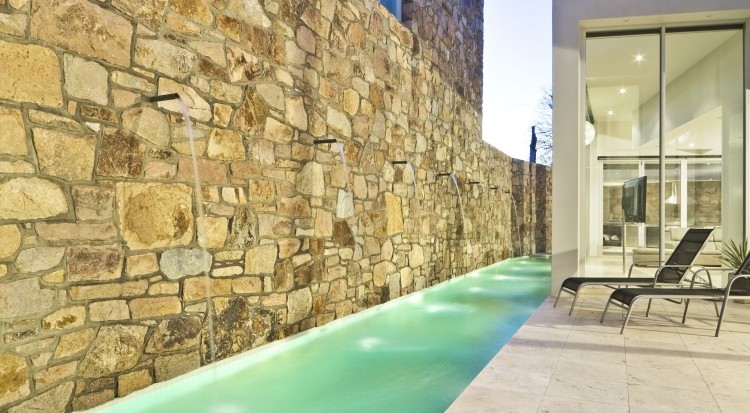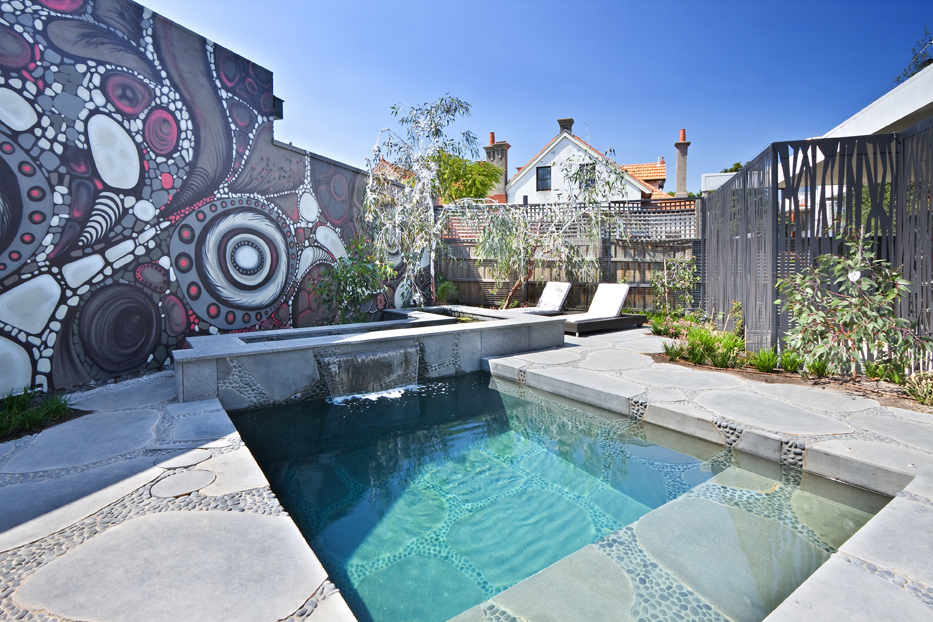In this guide we’ll explore the advantages and disadvantages of plunge pools from cost to care and everything in between.

This plunge pool built in Brighton is fitted to both the property boundary and the home boundary whilst forming a focal point for the eye from the living areas.
How much does a Plunge Pool cost?
A new plunge pool could cost you anywhere from $40,000 to upwards of $100,000. This is largely dependant on the size and what added extras you decide to include. To get a more accurate estimate, take a look at our inground pool cost calculator.
Also, keep in mind that the prices stated above also include the costs of designing the plunge pool as well as a 3D render of what your final plunge pool will look like so that you can experience what is to come.
Plunge Pool Advantages and Disadvantages
You might hear all kinds of reasons for someone wanting a plunge pool, but people sometimes leave out their biggest benefit- aesthetics. Plunge pools add an undeniable appeal and glamour to any space. They are eye-catching and can turn an ugly or awkward space, such as the gap between the home and fence, in to a real feature.
Compared to a full size pool, the downside is obvious – you can’t do much swimming in them. This means they’re sometimes less popular with the kids because there isn’t enough space for them to race one another or play pool games.
For adults however, this is hardly a disadvantage. You can still cool off on a hot summer’s day with friends, or turn on the jets and use them like a spa in winter. For that they can often better than a full size pool. Their small size is better for socialising with a drink or two, and they are cheap to heat during winter.
Helpful hints for building a Plunge Pool or small pool
- Build the pool tight to the space available, this means make use of property and fence boundaries.
- Make the pool deeper than normal i.e (shallow end depth of 1.4m instead of the standard 1.2m ). That way you increase the feel and volume of the pool in the third dimension (depth), which offsets the fixed constraints of Length and Width. The deep end water depth could be the same as the average pool ( 1.7m) or less. It would be pointless making it deeper as you can’t dive into a pool of this depth or surface area.
- Build seating into the pool – so you can get wet and relax.
- Don’t waste space on building step entries as you won’t necessarily have the space to waste. Not to mention elegantly entering a pool through a step entry seems at odds with the description of a “plunge pool”.
- A spa seat with jets can be easily built into the plunge pool form – so it fits more than one purpose.
- The small volume of a plunge pool means it can easily be heated with a heating system be that solar or gas – this further increases the utility of the structure.
This plunge pool in St Kilda is complete with its own “plunging watercourse”, whilst the bluestone round pavers and pebble inlay are a modern take on the pool at the base of a rock waterfall. Note how the pool is used as a focal point in the backyard as the available land constricts and tapers towards the rear fence. The eye stays fixed on the pool set at a splayed angle to mitigate the irregular shapes.
Maintenance
Sometimes, people are put off buying a pool as they believe their new in-ground pool will come with a headache of regular maintenance that will take up too much of their time. However, regular pool maintenance will take up all of 10 minutes per week. During this measly 10 minutes, you will want to perform these tasks to keep your pool in prime condition:
- Emptying and checking skimmer and pump baskets
- Skimming large leaf matter and debris off of the pool surface
- Checking the dosing equipment
- Adding salt and replacing the acid drum if required
- Dropping the robotic pool cleaner into the pool
- Backwashing the filter
It’s that easy.
All of our pools and fencing are built according to the Victorian Building Authority. Momentum pools is committed to designing and building the best and safest pool for your home.

